Introduction: In this article, Melissa Davenport Berry continues her series on Mayflower descendants, featuring the familial lines of Jessie May Doig, a direct descendant of Mayflower passengers John Howland and Elizabeth Tilley. Melissa is a genealogist who has a website, americana-archives.com, and a Facebook group, New England Family Genealogy and History.
This is a photo of the cenotaph placed at Burial Hill in Plymouth, Massachusetts, erected by the Pilgrim John Howland Society in 1958, memorializing the children of Mayflower passengers John and Elizabeth (Tilley) Howland.
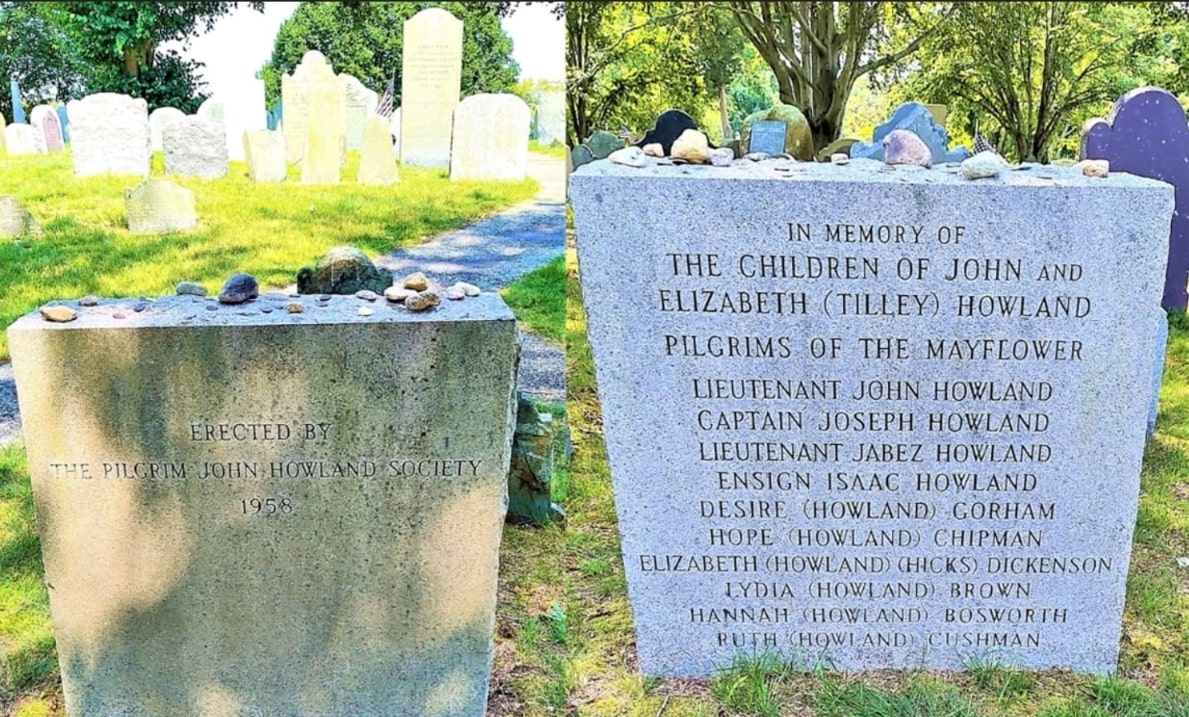
Today I continue my series on “Mayflower Descendants: Who’s Who,” featuring the familial lines of Jessie May (Libby) (Lumsden) (Carr) Doig (1921-2018), a direct descendant of Mayflower passengers John Howland and Elizabeth Tilley.
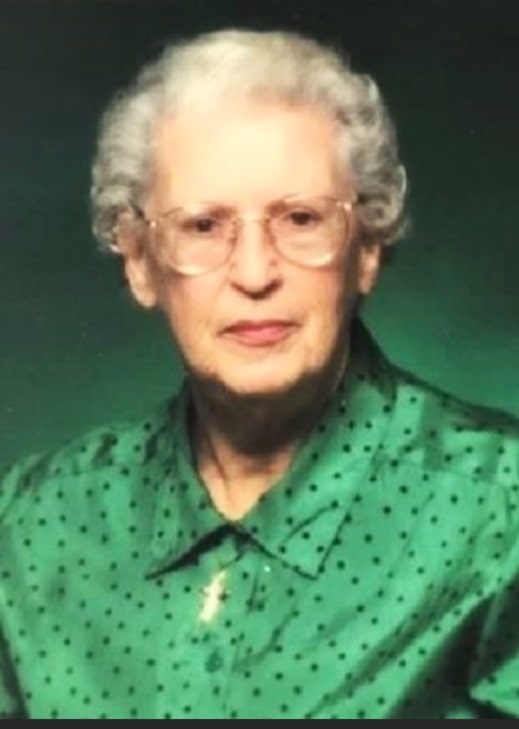
Lineage:
- John Howland and Elizabeth Tilley
- Jabez Howland and Bethiah Thatcher
- Samuel Howland and Abigail Cary
- Deacon John Howland and Martha Wardwell
- John Howland and Elizabeth Le Favour
- Daniel Howland and Rebecca Waldron
- Samuel Howland and Polly Waters
- Abigail Howland and Isaac Ball
- William Henry Ball and Mary Fawk
- Clifford Albert Ball and Jessie Evangeline McGrew
- Helen Evangeline Ball and Arley Ray Libby
- Jessie May Libby married 1st Evan W. Lumsden, 2nd Chester E. Carr, and 3rd Jack L. Doig; all predeceased her
The Jabez Howland house features fine period furniture and artifacts, including items from archeological digs at the Rocky Nook home of John and Elizabeth Howland and their son Joseph’s farm. Among the relics are letters and documents connected to the Howland family, including those from descendant Franklin Delano Roosevelt and “cousin” Winston Churchill (who is descended from Arthur Howland, John’s brother), and much more.
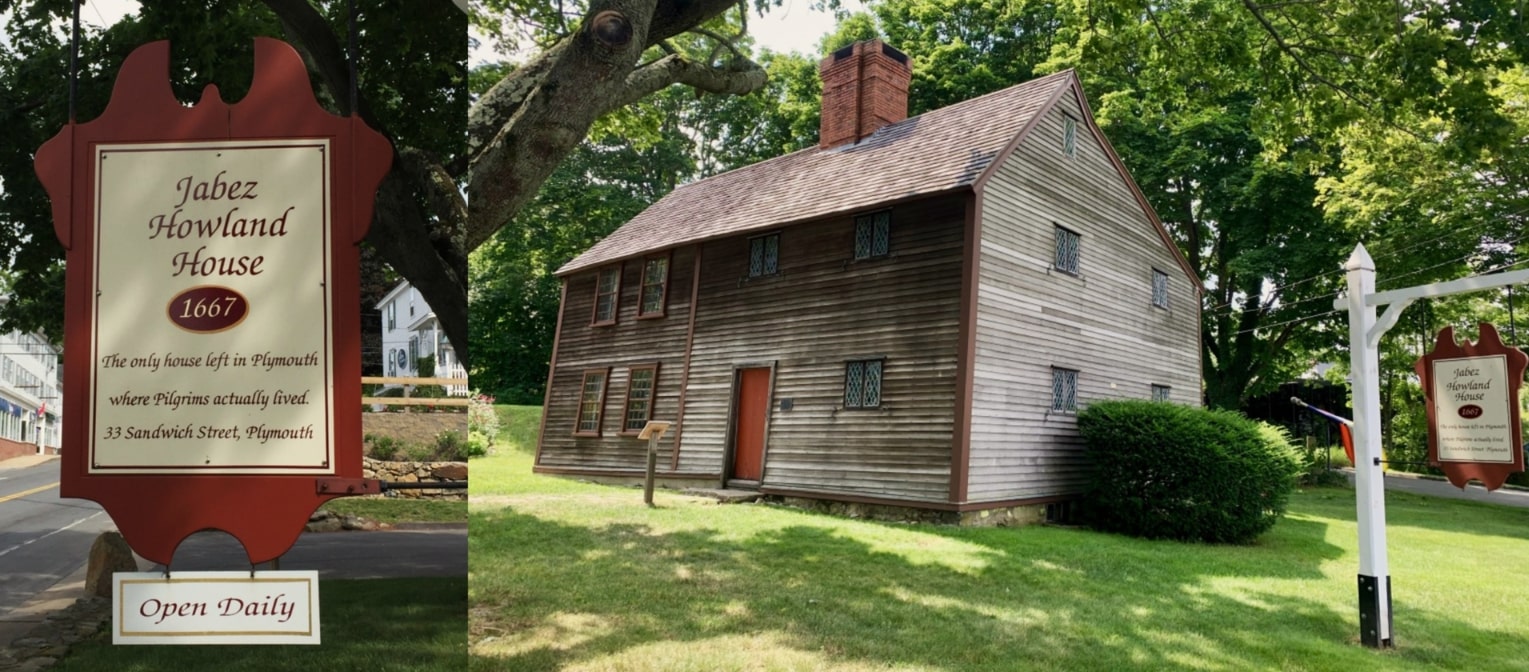
Jessie was a member of the Pilgrim John Howland Society, located in Plymouth, Massachusetts. She was proud of her Pilgrim ancestors who were among the brave lot to cross the Atlantic in 1620.
And if truth be told, Jessie and thousands of others who descend from John Howland would not be around today if not for a miraculous rescue while the Mayflower was crossing the Atlantic. As the historian Edward Rowe Snow wrote:
“John Howland, during a severe storm, was washed overboard, but by seizing the topsail halyards was rescued from drowning.”
William Bradford called Howland “a lustie young man,” and later he was given commendation by Bradford for being an outstanding member of the group. Read more: “Mayflower Descendants: Who’s Who, Part 31 (part 2).”
Jessie additionally paid homage to her venerable Oregon pioneer forefather Isaac Ball (1812-1895), son of Thomas and Martha (Brindley) Ball, who married Abigail Howland (1812-1900) in 1838.
In the spring of 1848 Isaac and Abigail, along with their six children, made the grueling journey on the Oregon Trail, arriving in Oregon in early October.
Below are tintypes of Jessie’s ancestors who founded Ballston, Polk County, Oregon.

Here is Jessie’s story of their adventure traveling west, as published in the Oregonian newspaper.
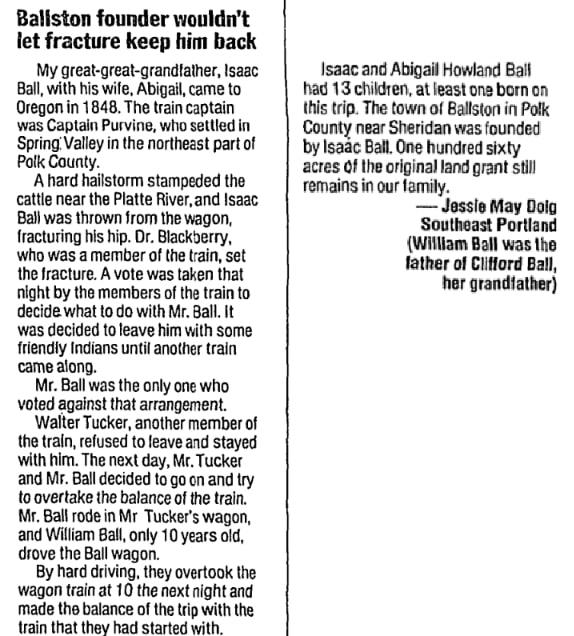
In Jessie’s words:
My great-great-grandfather, Isaac Ball, with his wife, Abigail, came to Oregon in 1848. The [wagon] train captain was Captain [John] Purvine, who settled in Spring Valley in the northeast part of Polk County.
A hard hailstorm stampeded the cattle near the Platte River, and Isaac Ball was thrown from the wagon, fracturing his hip. Dr. Blackberry, who was a member of the train, set the fracture. A vote was taken that night by the members of the train to decide what to do with Mr. Ball. It was decided to leave him with some friendly Indians until another train came along.
Mr. Ball was the only one who voted against that arrangement.
Walter Tucker, another member of the train, refused to leave and stayed with him. The next day, Mr. Tucker and Mr. Ball decided to go on and try to overtake the balance of the train. Mr. Ball rode in Mr. Tucker’s wagon, and William Ball, [Jennie’s great grandfather] only ten years old, drove the Ball wagon.
By hard driving, they overtook the wagon train at 10 the next night and made the balance of the trip with the train that they had started with.
Isaac and Abigail (Howland) Ball had 13 children, at least one born on this trip [their daughter Margaret Abigail (Ball) Comegys]. The town of Ballston in Polk County near Sheridan was founded by Isaac Ball. One hundred sixty acres of the original land grant still remains in our family.
Note: Isaac Ball’s injury is mentioned in William Porter’s letter home and a record of the incident is written in his diary:
June 4, 1848: Oxen ran off and it was noon before we broke up camp, traveled eight miles, and nineteen teams ran away with their wagons – broke Mr. Ball’s leg and crippled a number of oxen. Frightful sight.
According to sources, although Isaac Ball’s leg was not yet strong and he was still on crutches, he was not able to resist the California gold fever which was at that time spreading to all parts of the country, and he and William Graham went by water to California. They were having good success in their mining operations on the middle fork of the American River, but after an experience of 40 days Mr. Ball got hurt and was obliged to quit the business and return home. He brought home $400 (about $16,612 today).
Isaac’s leg never fully healed, and he had to walk with a cane which is now in the collection of the Oregon Historical Society. I hope for my next story I will have a photo for you. Also in the society’s collection are the Isaac Ball Papers, which include letters, deeds, and other important documents.
Isaac Ball was one of the initial advocates for the west side narrow gauge railroad project and organized a land donation fund. Below is a photo taken in 1958 of the abandoned railroad depot at Ballston.
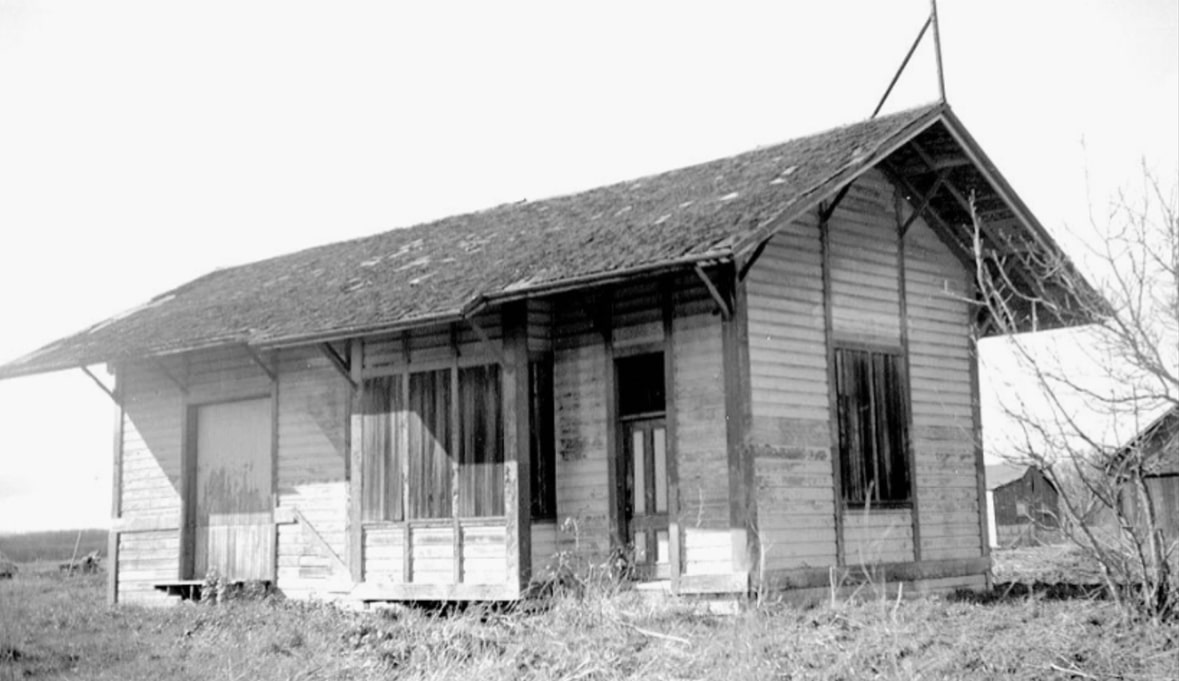
Stay tuned!
Explore over 330 years of newspapers and historical records in GenealogyBank. Discover your family story! Start a 7-Day Free Trial
Note on the header image: “Mayflower in Plymouth Harbor,” by William Halsall, 1882. Credit: Wikimedia Commons.
